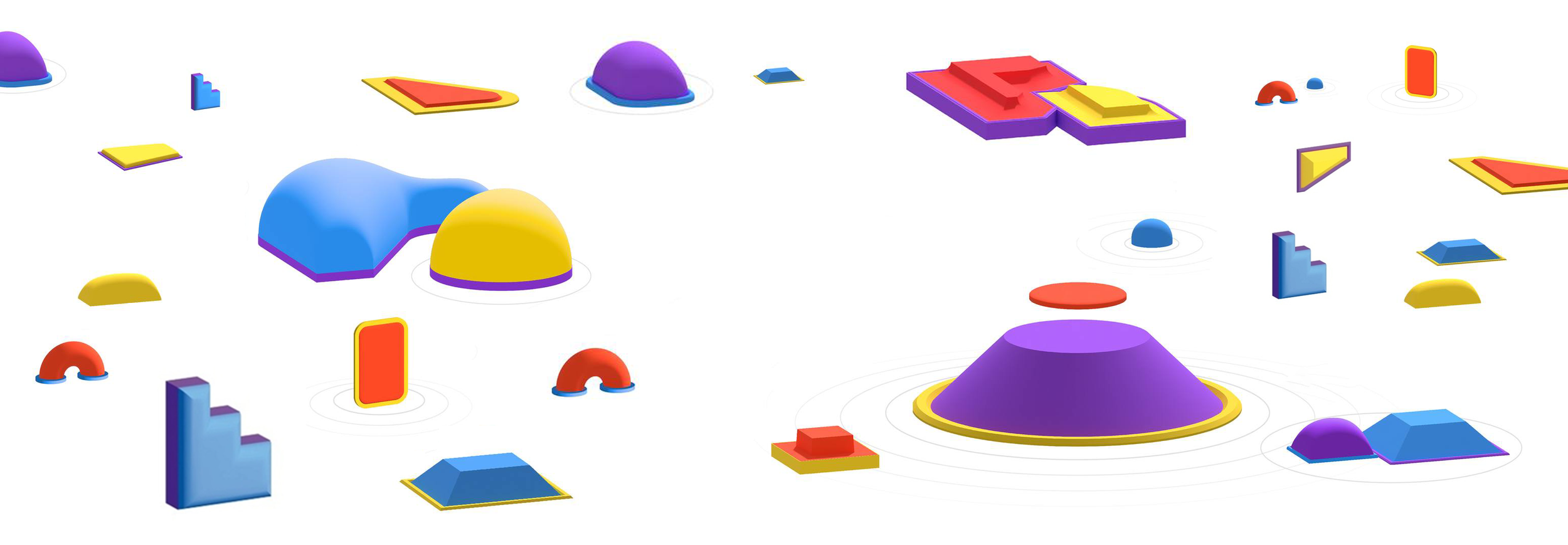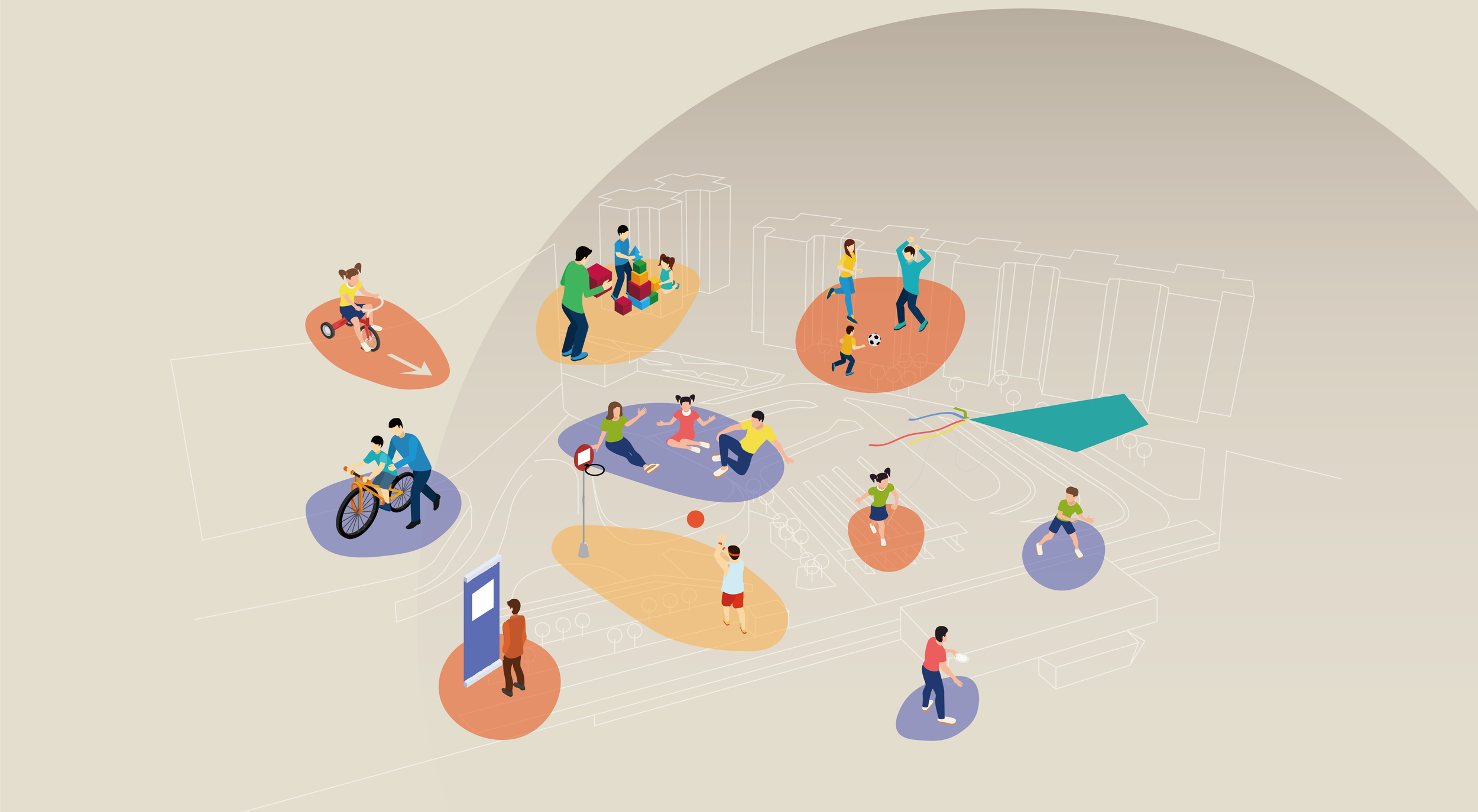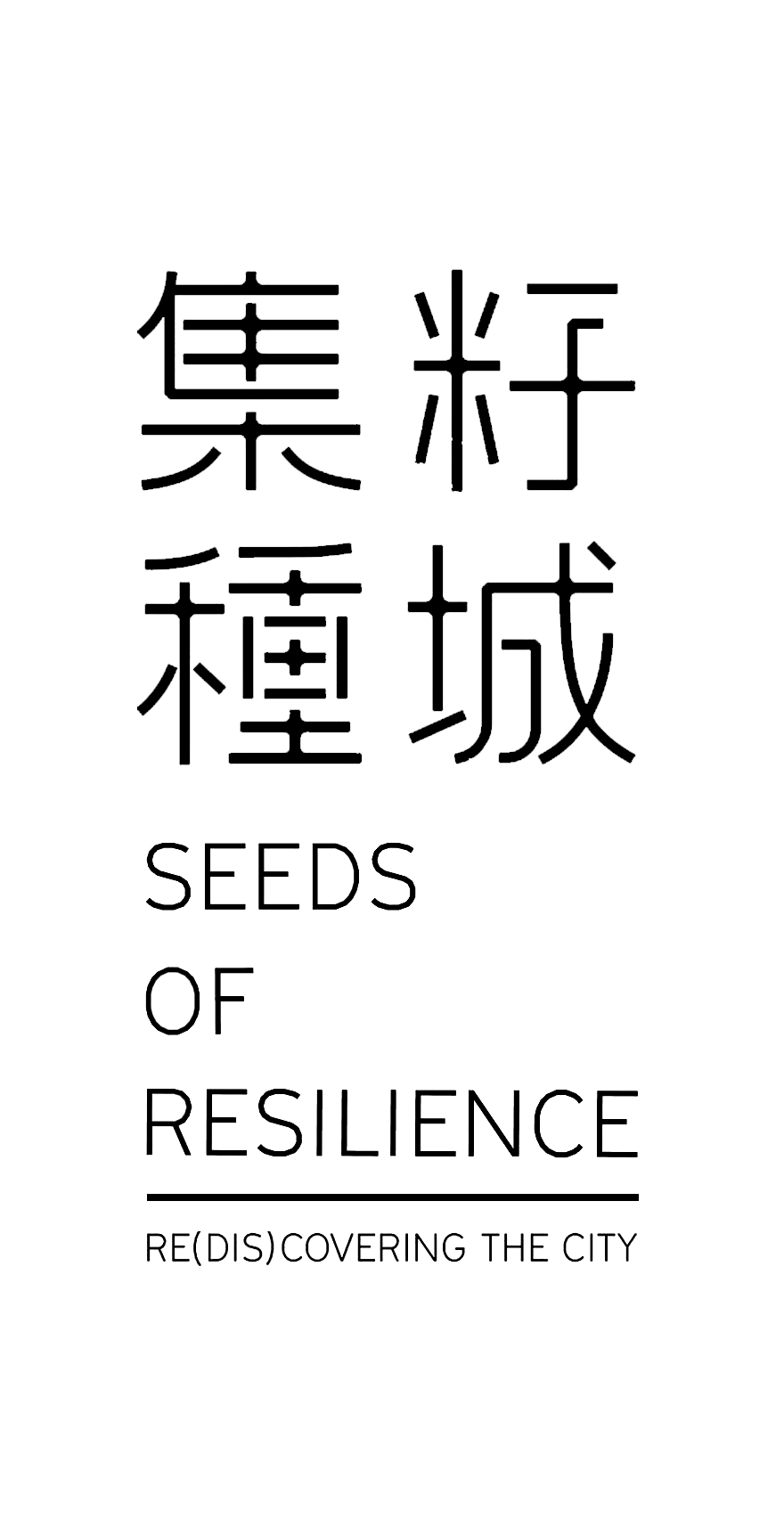Best viewed on desktop. 使用電腦瀏覽器以獲取最佳體驗。

2022 Hong Kong Shenzhen
Bi-city Biennale of Urbanism\Architecture
(Hong Kong)
港深城市\建築雙城雙年展(香港)
Introduction
簡介
Organised by the Hong Kong Institute of Architects (HKIA) Biennale Foundation and co-organised by the Hong Kong Institute of Planners (HKIP) and the Hong Kong Designers Association (HKDA), the 2022 Bi-City Biennale of Urbanism\Architecture (Hong Kong) (UABB) is now open. Under the main theme - “SEEDS OF RESILIENCE | 集籽種城”, UABB 2022 is not only held for the professionals, but also a platform facilitating the discussions and collaborations for the concerned topics among the public.
由香港建築師學會雙年展基金會主辦,香港規劃師學會和香港設計師協會協辦的2022港深城市\建築雙城雙年展(香港)現已開放,今年主題為 “SEEDS OF RESILIENCE | 集籽種城”。雙年展不僅是為專業人士舉辦,更提供一個促進公眾就社會關注的議題進行討論和合作的平台。
In the past few years, Hong Kong people’s lives have been transformed by multiple waves of crises. The overwhelming ‘shock and awe’ of these successive challenges has affected everyone differently. In times like these, where can we find hope? How do we resolve the conflicts within our city, and seek a new equilibrium that will allow the different elements of our city to co-exist? During this difficult time, people in Hong Kong continue to make positive changes to our society within their capacity. These bottom-up efforts, however big or small, are the seeds of resilience coming from the soil of Hong Kong. In UABB 2022, we shall re-discover the diverse seeds of resilience from the personal, communal, ecological and many more aspects, and put them under nourishing light.
過去幾年,一波又一波的危機改變了香港人的生活,這些接連不斷的挑戰對每個人產生了不同的影響。在這樣的時代,在哪裡可以找到希望?如何解決城市內部的衝突,尋求新的平衡,讓城市的不同元素共存?在這個困難的時期,香港人繼續在力所能及的範圍內為社會作出積極的改變。這些自下而上的努力,不論大小,都是來自香港土壤的韌性種子。在雙年展中,我們將從個人、社區、生態等多方面重新發現城市韌性的種子,並將其置於滋養的光芒之下。
VENUE & Opening Days 開放地點及日期
Central Market 中環街市
Date 日期:27/8-26/10
North Point (East) Ferry Pier 北角(東)渡輪碼頭
Date 日期:10/9-26/11
Central Pier No. 7 (Star Ferry)
中環7號碼頭(天星小輪)
Star Ferry Pier (Tsim Sha Tsui)
天星碼頭(尖沙咀)
Date 日期:10/9-26/11
MORE DETAILS 更多資訊
青年規劃師組 參展作品
Young Planners Group Exhibition Item
遊樂實驗室@紅磡
Play Lab @ Hung Hom
Exhibition Period 展期︰27.08 - 26.10.2022
Exhibition Venue 展覽場地︰Central Market 中環街市


1 背景
BACKGROUND
-
自從紅磡碼頭對開廣場的巴士總站於2019年遷移後,這個露天的前巴士總站暫時為閒置空間。我們留意到現時有公眾會自發在這裏進行不同活動,例如兒童遊樂、單車/滑板車、康體運動等等。
這個公共空間為規劃中的紅磡都市公園的一部分,政府與各界正研究設計方案,配合康樂及文化事務署的「紅磡海濱休憩用地發展」項目,以及紅磡(南)渡輪碼頭美化工程的進展,期望進一步提升公眾在這幅用地的體驗。
這個地方本來只是一個空無一物的閒置空間,但透過市民間的互動和自發的活動,現已成為街坊們的休憩聚腳地,甚至是為小朋友而設的遊樂空間。我們希望在現有的有機發展之上,觀察一下不同形式的街道裝置如何帶動和促進空間使用。
我們香港規劃師學會(HKIP)-青年規劃師組(YPG)的實驗團隊利用創意在這個閒置空間放了不同的街道和玩樂裝置,嘗試觀察和了解這些裝置如何影響不同人使用此空間時的行為和體驗,從而研究如何簡單有效地利用低成本物資為未被充分利用的土地增加活力,同時為公眾提供創新的城市體驗。我們在2022年6月26日(星期日)下午在這個閒置空間順利完成了約4小時的社會實驗,是次實驗也得到不少街坊朋友們的支持。
透過我們準備不同的快閃玩樂裝置,我們觀察到小朋友和街坊在有限的資源下仍能發揮創意,將空間變成臨時的遊樂場,令我們反思不同街道和玩樂裝置與城市生活的關係,也探討民間(包括小朋友)其實在空間規劃上也扮演著一個重要角色。此舉也相信能引起社會大眾對城市規劃和空間設計的關注。
我們團隊深信由下而上的規劃和實驗性的設計是未來地方營造和城市規劃的可行方法,而且城市規劃的未來不應受限於其專業定位,應該鼓勵不同人一同參與,合力建構屬於大家的城市空間。
-
Since the relocation of the bus terminus at the plaza opposite to the Hung Hom Ferry Pier, this former bus terminus have been left idle since 2019. We noticed that there are more organic and interactive activities in this park than ordinary parks, such as children's play, bicycle/scooter, sports and so on.
This public open space is a part of the Hung Hom Urban Park under planning. The Government and the public are exploring different design options in utilising this space to enhance public experience. This site may also synergies with the nearby “Open Space Development at Hung Hom Waterfront" project by the Leisure and Cultural Services Department and the beautification of the Hung Hom (South) Ferry Pier.
People have been using the site for different activities on their own initiative. The site has become a common ground for resting and a playground for kids. Building on such organic development, we would like to observe how the street furniture stimulates and facilitates the use of space.
Our experimental team, the Young Planners Group (YPG) of the Hong Kong Institute of Planners (HKIP) adopted some intervention strategies in this vacant space near the pier to see how different installations and street furniture may affect users’ behaviours and experiences in the urban spaces. The project also provides insights on some effective means and materials in creating installations to enhance urban vitality and create unique urban experiences. This social experiment was carried out on 26th June 2022 afternoon for around 4 hours. A lot of local residents showed their support for our experiment and project ideas.
With the different installations created and provided by the team, many kids and local residents made use of their creativity and explored ways to utilise the space. The space temporarily became a playground for different groups of people. It reminds us of the close relationship between urban street furniture and installations and urban living. The experiment also implied that the local community groups (including kids) are playing indispensable roles in spatial planning. Our team believed that bottom-up planning and experimental design will provide us with feasible insights on future place-making and urban planning. Different groups of people can work together and play a part in creating a better place which belongs to everyone.
2. 基線觀察
Baseline Observation
-
我們留意到這裡比一般公園更有機和互動地進行多元化的活動,例如兒童遊樂、單車/滑板車、康體運動等等。每逢假日或平日放學後的時間,便會有不少家長帶同小朋友前來玩樂。
碼頭廣場對小朋友而言是游樂場、賽道、與朋友相聚的地方。但是,在小朋友玩樂的同時,照顧者通常會在烈日當空的碼頭廣場一旁默默等候。有趣的是,我們也觀察到,有些家長會自發地帶私家凳子坐在路肩,跟其他照顧者閑聊。
下午12-3點期間,碼頭廣場比較少街坊使用,可能是因為陽光較為猛烈,而現場缺乏遮蔭。不時也看到有很多小朋友會沿著舊有的巴士月台和車坑來踏單車和滑板車,他們玩樂的「賽道」也比較單一/固定和沉悶。
實地觀察開始激發我們開始思考:「假若我們提供一些小道具,加些民間智慧,能否更有效提升由社區合力建成的公共空間呢?透過一些可移動的裝置,我們能否為不同人營造一個更優質的城市空間和用家體驗呢?」這些問題便引申出是次實驗項目。
-
We observed that there are more organic and interactive activities found in this vacant site than other parks. Various groups of people are carrying out different activities, including jogging, cycling, playing scooters, doing workouts, along the lay-bys. It is common to see many parents bringing their kids to play here during weekends, holidays, and some weekday afternoons after school.
The pier plaza is the “playground”; “race-lanes”; “gathering points” for the children. While the caregivers usually stand aside to keep an eye on their children. We observe that some of the caregivers brought along their own stools; begin chit-chatting with each other.
There are less space users found in the plaza during 12-3pm. It is quite sunny there while there is a lack of shading.
It is common to see kids cycling or riding scooters along the existing “track” formed by the former bus lanes and lay-bys. Users may find this quite standardised and boring for cycling and other different activities.
Given the diverse behaviors of the co-users as observed, we are inspired to imagine: If we provide some small props to the area, will it enhance the experience of all users of the community-led / built public space? Could some movable furniture also help create better urban spaces and user experiences? These all imaginations and questions inspired our team to carry out this project and social experiment.
3. 快閃裝置
POP-UP INSTALLATION
-
舊巴士總站的停車灣把空地分割為一條條的走廊,我們觀察到空間使用者會自然地沿著走廊進行動態的遊樂活動,例如單車、滑板車、駕駛模型車。對使用者而言,碼頭廣場是由一條條賽道構成。我們回應現時在碼頭廣場上的活動,利用終點線、路牌、交通錐等裝飾勾畫出一條競賽賽道。然而,在活動當日我們發現使用者並不會沿著規定路線競賽,只會自由地享用空間。這反映出使用者比規劃者在遊樂和空間的使用方法上更有創意和理解更深。
The bus lay-bys of the old bus terminus cut the site into lanes. We observed dynamic activities along the lanes, like cycling, riding scooters, and driving model cars. The pier plaza means “racing-lanes” to the current users. To complement the current uses, we used finishing lines, road signage, and traffic cones to design a race track. However, we discovered that the users would not confine themselves to the race track. They have their own way of racing and utilising the space, as demonstrated in the experiment. It reflects that the actual users have a higher degree of creativity and understanding of the space.
我們亦配合競賽主題,提供簡約組裝的步行車給小童遊玩。小朋友雖然對步行車感興趣,但未有主動接觸或互動,他們需要照顧者或工作人員的鼓勵才會開始遊玩。當一些小朋友開始使用步行車,其他小朋友會受到吸引,從而形成一個更大的遊玩群組。
To echo with a theme of “racing”, we provide some simply assembled go-carts for children. Although they are interested about the carts, they need some encouragement from the caregivers and facilitators to play with the toys. Other kids are attracted when some people are playing with the go-carts, and it forms a larger playgroup.
根據現場觀察到的現有使用情況,大部份用家為使用非機動車輛的兒童。旨在通過使用路牌及交通標誌形成賽道以建立賽車主題。團隊以剩餘物資設計了各種標誌來顯示方向並指導用家的路線,亦可用來裝飾賽道。
In line with the existing use of non-motorised vehicles observed at the site, it was intended to establish a theme of racing by forming a track using signages. Various signs were created to show directions and direct the routes of users. They were designed only for decoration.
旨在通過提供坡道將現有行人道連接到地面以克服高度上的差距。團隊收集了紙皮箱並組合成緩坡,供非機動車輛(例如踏板車、自行車、滑板、步行車或平衡車等)使用。除了平坦的賽道以外,緩坡可提供不同路線以帶來更豐富的玩樂體驗。即使步行車無法像預期般輕易地使用坡道,但坡道仍然吸引了一些其他用家。例如騎自行車或踏板車的小孩嘗試利用坡道上落。
Designed to connect the existing aisles to the ground by providing ramps to overcome the level difference. Recycled cardboards were collected and combined to form gentle slopes to be used by non-motorised vehicles (e.g. scooters, bicycles, skateboards and race carts, balance or pedal bikes). Varied routes other than a flat track could be provided for an enhance experience. Although the ramps were not as accessible by the race carts as expected, the ramps attracted some other users, including kids riding bicycles or scooters. The users tried to ascend and descend using the ramps.
-
我們留意到場地內有不少柱類構築物,如燈柱、水/電管道及構築物的支柱等。為善用現有環境和利用垂直空間,我們於遮蔭處的管道支柱設置籃球架。活動當日,由於其位於碼頭廣場最陰涼的地方,所以能夠吸引幼童、青年、成人投籃玩耍。
We noticed that there are a lot of columns that are used by the former bus terminus, such as lamp post, water / electricity pipelines and columns of the built structures. To make use of the existing context and develop the vertical space, we set up some basketball hoops on a pipeline column. As it is the most comfortable place on-site with shading and sea breeze, kids, youngsters, and adults come and play.
我們一開始只裝置了一個籃球架,高度約可讓一個青少年玩,但經過觀察和實驗,我們發現增加不同高度的籃球架能讓更多不同年紀的參加者有成功感,也讓遊戲更有挑戰性。現場提供了幾個不同顏色的皮球,以鼓勵更多動態活動。團隊主要將皮球放置在籃球架附近,供孩子們投籃。它們亦吸引了不同年齡的小孩在場地周圍自由地扔球和踢球,它們的使用不僅限於籃球架附近。除了獨自或與父母一起玩耍外,有些年幼的小孩更會與其他年齡相近的小孩互動,會觀察到一些社交互動。
At first, we only set up one basketball hoop, which is of the height that a teenager can play. After a trial and error process, we realize that setting up hoops at different heights can enable participants of different age to have a better sense of achievement and can also make it more challenging and interesting.
Several balls of different colours were provided at the site to encourage more active usage, which were mainly placed near the basketball hoops for kids to shoot into the hoops. The balls attracted kids of a wide range of ages, who freely threw and kicked the balls around the site. Their usage was not limited to nearby the hoops. They either played alone or with their parents. Some social interactions were observed when young kids interacted with other kids of similar age.
因安全考慮,彈床在遊樂場並不常見。團隊將彈床放置在連接在支柱上的籃球架附近,作為皮球的彈跳台。有別於預期的用途,有不少孩子們獨自在彈床上跳得很開心。 我們發現大部份家長並不是太擔心安全問題,反而鼓勵小朋友自己在彈床上遊玩。
Due to safety concern, trampoline is not always found in usual playground facilities. Installed as a bouncing agent for the balls, placed near the hoops attached to the poles. Unlike the expected use, the kids had fun jumping on the trampoline alone. We recognize that most parents are less worrying on the safety aspect as we thought and they will encourage their children to jump on the trampoline on their own.
-
有見舊巴士總站已是個現存的「遊樂場」,我們希望提供方便移除的遊戲裝置,讓使用者有更多玩樂種類選擇,加強舊巴士總站的「遊樂」元素。舊巴士總站留下的車坑如同天然賽道,我們希望加以利用這場地特色,將其中一條車坑轉換為保齡球道作玩樂用途。除保齡球外,我們為小朋友提供無固定形態的泡沫橡膠棒。設計意念是讓小朋友自行決定玩樂方法,共同營造一個玩樂公共空間。
We want to give the users more playing alternatives by providing removable game installations in this existing “playground” to boost its “play” element. The bus bays left from the former bus terminus are natural racetracks and we think it would be a good idea to adapt to the site features for playing by turning one of the bus bays into a bowling alley. Apart from bowling, we provided freeform foam sticks for kids. The design idea is to allow them to decide their own way of playing and to co-create an open space for fun.
雖然保齡球看起來已有標準玩法,有些小朋友還是自行研發新玩法。有個小男孩提議設置兩條平行保齡球道,讓他可以和他的朋友比賽。小朋友能夠想到以互動形式玩樂,實在不錯!小朋友也興致勃勃地提出保齡球瓶的擺法(例如三角形該看起來怎樣)。家長視此為教育機會,教導小朋友在擊球後幫忙執拾球瓶,而有些小朋友也主動提出幫忙。家長教導小朋友排隊玩保齡球,小朋友亦十分耐心乖乖等候,整個玩樂氛圍都很正面。保齡球瓶後方是拼圖軟墊,小朋友發揮創意,用這些軟墊設計龍門。由此可見,場地上每件物品都可以是實驗目標!
While a bowling game may sound standard with already defined common game rules, some kids improvised the way to enjoy the bowling game. A boy suggested setting two parallel bowling alleys so that he could have a match with his friend. It is nice to see that kids came up with an interactive way of playing! Kids were also eager to suggest their desired ways to place the bowling pins (for example, how the triangular shape should look like). Parents treated the bowling game as a chance to educate their kids to help with clean-up and some kids offered help proactively. With parents asking kids to take turns to play and kids queuing up patiently, a positive playing atmosphere was formed. Behind the bowling pins were the puzzle playmats we brought, with which kids designed the goals creatively. Every piece on site could be a subject of experimentation!
我們觀察到,在沒有團隊成員在旁引導下,小朋友和家長都能自行想到創意的方法去使用這些玩樂裝置。他們使用泡沫橡膠棒的玩樂方法包括跳飛機和進行障礙賽(跨欄和穿過拱門)。小朋友用泡沫橡膠棒砌成不同形狀,並以不同方式擺放它們,設計自己專屬的障礙賽道。使用者的確會根據現有物資想出最能切合他們需要的方法並加以利用。這正是我們這次實驗想要測試的。
We observed that kids and parents enjoyed the game installations by inventive improvisation even without our facilitators. Their ways of playing with the foam sticks included hopscotch and obstacle race (hurdling and running under an arch). Kids designed their obstacle tracks by creating multiple shapes with the foam sticks and placing them in different arrangements. Users indeed adapted what is available to best suit their own needs, and this is exactly what we wish to test in our experimentation.
-
雖然舊紅磡碼頭巴士總站對小朋友來說是個很吸引的遊樂場,但是缺乏座椅和遮蔭地方,對家長來說並非舒服的環境。我們也發現這片空地的使用者需要可以讓他們擺放水樽和手提電話等個人物品的地方。所以我們決定製作有遮蔭功能的座椅,放於舊巴士總站,測試這張座椅能否滿足使用者的需要。這張長凳完全由紙皮製成,而遮蔭的上蓋則以回收舊膠織袋製成,顯示臨時而實用的城市家具和裝置可以用可持續物料製作。我們希望用便宜又易收集的物資手工製作城市裝置,說明以臨時或小型的方法戰略性地改造城市環境和生活並非難以實行的事,而每個人都可以透過參與由上而下的社區設計活動做到這樣的效果。
The site is a nice playground for kids, but is lacking of seating and sheltering, which the condition may not be ideal for parents. We also found that users may want a place to put their belongings such as water bottles and mobile phones. We therefore decided to create seating with shelter and put it at the site to see if it can satisfy users’ needs. To illustrate that temporary urban furniture and installations for practical uses can be made of sustainable materials, the bench is completely made of cardboards and the shelter is made of a recycled plastic woven bag. Handmaking urban installations with inexpensive and readily accessible materials, we hope to exemplify that tactical urbanism is not something difficult to achieve and everyone of us can do so by participating in bottom-up community design initiatives.
活動開首,並不是很多人留意到這張座椅。一名家長擔心紙造長凳不夠安全穩定,叫子女不要坐在上面。雖然如此,但這沒有打擊我們的信心,因為這次活動的本質就是一個實驗。為了吸引大家使用長凳,我們把它移到讓人更易看見的位置,並在上面寫上「都攰喇!坐下啦!坐得㗎~」。我們亦發現遮蔭上蓋不如想像中重要,因為太曬的話,大家都會直接選擇不出來玩。
At the beginning, not a lot of people noticed the seating. A parent felt skeptical about the sturdiness of the paper-made bench and told her child not to sit on it. This did not discourage us as we understand that our event is experimental in nature. To attract people to the bench, we moved the bench to an area that is more visible and wrote “Are you tired? Come take a seat! It’s usable~” on it. We also noticed the shelter was not as necessary as people would rather stay away from the sun than to sit under the heat.
4. 總結: 快閃遊樂場
- 公共空間的共同想象
Conclusion: Pop-up Play Lab - Co-Imagination of Public Open Space
-
臨近紅磡碼頭的露天巴士總站自二零一九年搬遷後便已空置,即使該地並沒有增設常見的遊樂設施,小朋友自發地將其轉變為一個廣受當區人士歡迎的「兒童遊樂場」。小朋友發揮創意,把原本的巴士泊位當作踩單車和滾軸溜冰的賽道。這正正顯示了公共空間的使用者如何自發地發掘該地適切的用途。我們相信用家才最了解自身需要。因此,鼓勵用家共同參與公共空間的規劃和設計,並了解他們實際所需是尤為重要。
政府近年來對海濱空間採取的「先駁通,再優化」策略正是良機,可與用家共同探索閒置的海濱公共空間用地的合適用途及長遠的規劃設計。以紅磡碼頭附近的舊巴士總站為例,雖然該地自二零一九年就被規劃作城市公園,但是其最終設計至今仍在敲定。閒置的海濱公共空間能「先駁通」讓市民盡早使用固然是好,但我們是否能更進一步,令不同的海濱空間制定更佳的臨時使用策略呢?
在紅磡碼頭附近的舊巴士總站的例子中,從小朋友對閒置空間的創意運用,我們觀察到該社區缺乏的是一些可踩單車、滾軸溜冰及遛狗的動態康樂用地。通過該實驗,我們進一步探索到該公共空間的更多可能性 - 提供予照顧者的有蓋座位、提供予小朋友的創意玩樂設施。
然而不同社區需要的設施往往不盡相同。因此,我們可以通過設計和引入不同的快閃遊樂裝置和其他設施,以測試出不同社群最需要和設施。通過觀察用家如何使用這些快閃裝置,設計者亦可能取得新靈感和想法 - 就正如在這次實驗中,我們觀察到小朋友拆開紙板座椅,並將其轉變成一個新的玩樂裝置。
-
Upon relocation of the open-air bus terminus adjacent to the Hung Hom Ferry Pier in 2019, the site where our experiment took place has been naturally transformed to a “children playground” despite that no conventional play equipment is provided. The children creatively turn the bus bays to racing tracks for cycling and rollerskating, which demonstrates how the users appropriate the use of space by themselves. We believe that users themselves are who know the best of their needs. Therefore, in planning and designing the uses of public open space, allowing and encouraging the participation of the actual users is of crucial importance to understand their expected future uses.
The incremental approach adopted by the Government in recent years provides an opportunity to encourage participation of users in collaboratively exploring the appropriate future facilities and design of the space. Take the open-air bus terminus near Hung Hom Ferry Pier as an example, the site has been planned as a new urban park in 2019 after the relocation of the bus terminus while the design of the new urban park takes more than two years to finalize. It is good that the site is open for public enjoyment during these two years under the incremental approach, but is there anything we can do further to make better interim use of the space?
Just like the example of the old bus terminus near Hung Hom Ferry Pier, we understand what facilities are in lack of and what people are expecting through the current creative uses - active recreation space for cycling, skating and dog-walking. We explore more possible uses of the space through the experiments - sitting-out area with shelters for care-givers, flexible play facilities for children.
While the much-needed facilities for different neighbourhoods are never homogeneous. Therefore, experiments in the form of pop-up play equipment and ancillary facilities could be a possible way to test out the most wanted facilities for the space by the users. The park designers might also gain inspirations on the possible uses which are beyond our imagination - just like the paper bench being uninstalled by children and turned into a brand new play equipment in our experiment. Introduction of pop-up play facilities not only enable more flexible uses and provide more interesting experience for the users on the vacant site, but also helps to determine the final design through co-creation and co-imagination of the space with the communities.
EXHIBITION VIDEO 參展片段
HKIP Young Planners Group (YPG)
香港規劃師學會青年規劃師組
Acknowledgement 鳴謝
Kay Chan Wan Ki
陳韻淇
The Warehouse Teenage Club
蒲窩青少年中心
Department of Urban Planning and Design, The University of Hong Kong
香港大學城市規劃及設計系
Armor Chui


















































